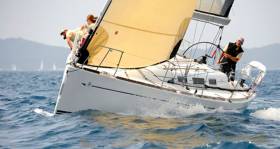Displaying items by tag: Dufour 40
Dufour 40 Performance Sailing Cruiser is A Real Life–Enhancer
It tells us much about the intrinsic quality of a boat if her looks don’t seem to date writes W M Nixon. The debut of the Dufour 40 Performance in 2002, as the result of an interesting design linkup between Umberto Felci and Patrick Roseo, drew a telling level of interest from discerning sailors. They saw a carefully-planned boat which didn’t look outrageously modern, yet had a certain quality which suggested she still wouldn’t look dated twenty years hence.
Fifteen years ago, one of the most experienced and thoughtful sailors in Cork decided that here was the dreamship, and by 2003 his new boat was in Crosshaven. She demonstrated with a lively mixture of family sailing, white sail racing and cruising, that she was everything the pundits expected, and more.
Sadly, that first owner, one of Irish sailing’s great life-enhancers, was taken from us all too young. It was felt that selling his beloved boat away from Crosshaven would ease the pain. Yet such had been the friendly effect that this boat had made on everyone with her first owner that, as a mark of respect, the new buyer on the East Coast retained the track on the chart plotter of his final year in his beloved Cork Harbour.
Now, that second owner has realised that the years are passing, and he has a fascinating new line in boat ownership in mind, a completely new track to mark the passing of a landmark birthday. So this dreamship is for sale for only the second time, and at the very sensible price of €89,500. The layout allows for the forward stateroom to be completely en suite.
The layout allows for the forward stateroom to be completely en suite.
I’ve had the pleasure of going to sea on her, and she’s as good-natured a boat as you’ll come across in many a day’s sailing, while having an unexpected yet very real oomph in her performance, which makes a spot of racing unexpectedly rewarding. But in the bigger picture, undoubtedly she’d give of her best with well-planned and maybe extensive cruising based on a judiciously-balanced programme between longer hops and detailed visits to intriguing ports.
She handles a treat under sail or power, and has enough assisted gizmos to make the prospect of a quick evening jaunt after a harassing day at the office just the ticket to revive the spirits. As I said, that much-missed first owner was a noted life-enhancer. I think this boat is too. She comes very highly recommended, full details on Afloat.ie's Sailing Cruisers for Sale here.
























































